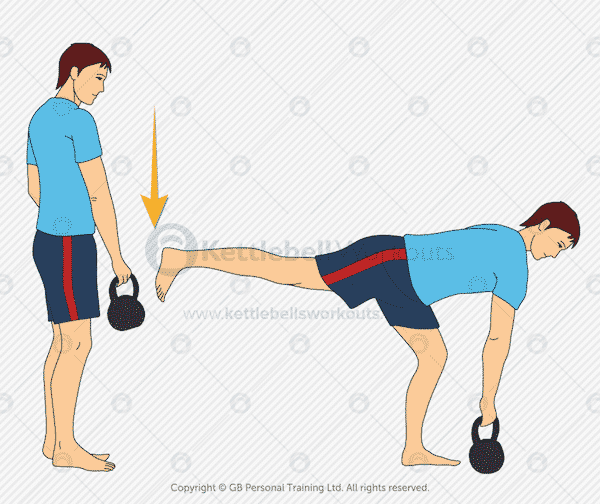Happy Thursday to you,
First a quick reminder that after tonight I will no longer be offering my kettlebell DVD.
If you want to follow along with me as we go through 21 kettlebell workouts then now is your chance.
I understand that not everyone has a DVD player or has moved on from this type of tech, if so you can of course get all my programs online from my website.
OK, let’s look at a groovy exercise that you may have not tried yet or find a real challenge…

Single Leg Deadlift
I get more emails about the single leg deadlift than any other.
It is included in most of my programs, including my DVD, and is an exercise that I really believe everyone should practice.

Here’s why I like it:
- Corrects left vs right movement imbalances
- Programs the hip hinge which is vital for the swing and correct pelvic movement
- Diagonally connects the shoulder to the opposite hip via the core muscles
- Improves single leg balance to prevent falls in seniors
- Heavily activates the posterior muscles: buttocks, hamstrings, back and core
- Develops good timing to prevent lower back issues
The other great thing about the single leg deadlift is you can modify the exercise to accommodate beginners to the very advanced.
First, I would recommend that you master the single arm deadlift standing on two feet before progressing to the following single leg variations:
- No kettlebell, reaching forwards (beginner)
- One kettlebell, reaching down
- Two kettlebells, reaching down (advanced)
You should keep the reps low for the single leg deadlift and take your time.
Around 4 to 6 reps is usually about right.
If you play sports, struggle with balance, suffer with back issues due to poor movement timing, or want rock hard Glutes…
Then you really should practice this exercise.
Here are some common errors I see:
- Leg and back don’t stay in a straight line – keep your core muscles braced and tight and lead with the rear leg allowing the body to follow
- Hips open up and the rear leg rotates outwards – keep those rear toes pointing down and the hips closed
- Shoulder reaches for the floor – keep the shoulder up and in it’s socket and allow the pivoting of the hips to reach you towards the floor
- Fall forwards onto the toes and nosedive – keep your knee slightly bent and weight back on your heel, you can even curl your toes back slightly
Beginners with balance issues should reach towards a wall or perform the exercise next to a wall so they can catch themselves if necessary.
Those more advanced can load up with 2 kettlebells but not risk overloading their spine due to the lower load needed for single leg training.
No matter what your level, take some time over the next week to practice the single leg deadlift.
Your core, legs, balance, and Turkish get up will thank you for it.

Here’s the single leg deadlift in action from my DVD:
- Single leg deadlift – left x 30 secs
- Halo – clockwise x 30 secs
- Single leg deadlift – right x 30 secs
- Halo – anticlockwise x 30 secs
- Goblet squat x 30 secs
- Slingshot – change directions every 5 reps x 30 secs
- Single arm deadlift x 30 secs each side
Today’s workout really gets those buttocks, lower back and legs working.
As you can see from the above workout I’ve mixed up 2 deadlift variations along with some active recovery exercises for the upper body.
It’s amazing how something simple like the above 4 minute workout gets your cardio up while at the same time working through those all important movement patterns.
Those more advanced can use 2 kettlebells for the single leg deadlift and squats.

This weeks question:
Q. “Is there any other exercise, that gives me the same benefits, that I can substitute for the windmill or should I just lower the weight?”
A. The windmill is a difficult exercise that requires good shoulder stability as well as hip flexibility. If you suffer with either of these issues then you will find the windmill very challenging.
Before you progress to the windmill you should feel comfortable holding a kettlebell overhead for 30 to 60 seconds. You can even walk around with it overhead. If this causes pain then you need to stop all overhead exercises and work on your shoulder mobility / stability.
If your flexibility / core muscles cause issues when lowering into the windmill then you need to practice the movement without the kettlebell. Practice the movement and also work on your general hip mobility daily.
There is no one exercise that you can substitute for the windmill but you can practice the movement without a kettlebell to work on your flexibility.
I hope this helps.
Take care,
Greg

